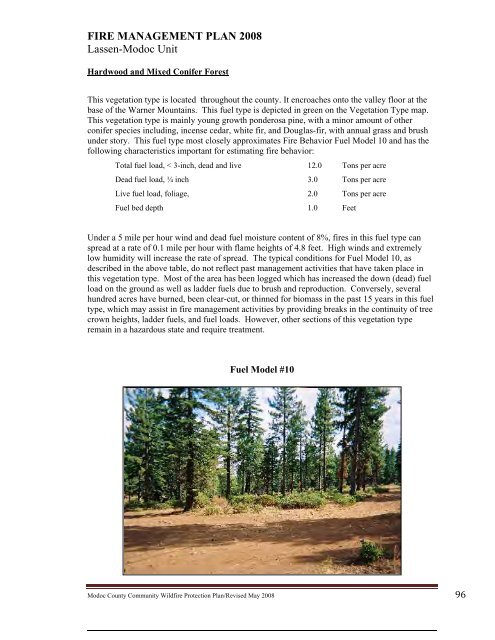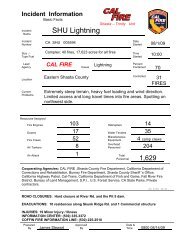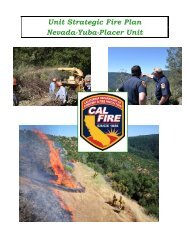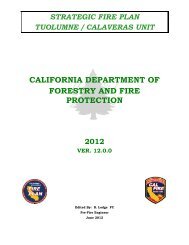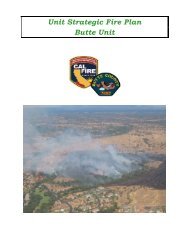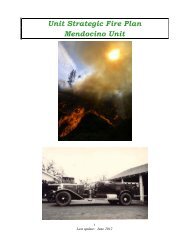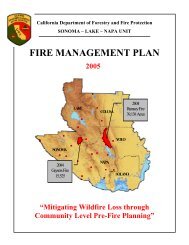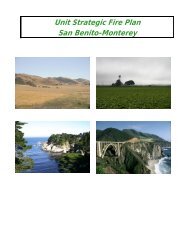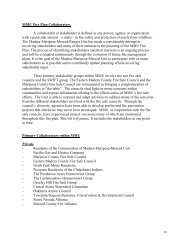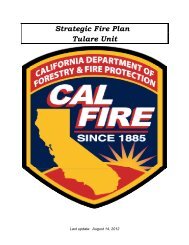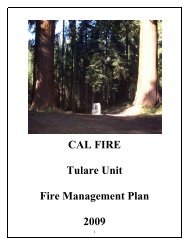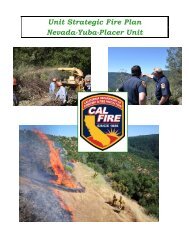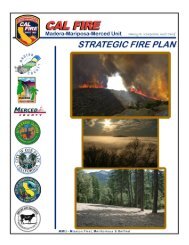Lassen – Modoc Unit - Board of Forestry and Fire Protection - State ...
Lassen – Modoc Unit - Board of Forestry and Fire Protection - State ...
Lassen – Modoc Unit - Board of Forestry and Fire Protection - State ...
Create successful ePaper yourself
Turn your PDF publications into a flip-book with our unique Google optimized e-Paper software.
FIRE MANAGEMENT PLAN 2008<br />
<strong>Lassen</strong>-<strong>Modoc</strong> <strong>Unit</strong><br />
Hardwood <strong>and</strong> Mixed Conifer Forest<br />
This vegetation type is located throughout the county. It encroaches onto the valley floor at the<br />
base <strong>of</strong> the Warner Mountains. This fuel type is depicted in green on the Vegetation Type map.<br />
This vegetation type is mainly young growth ponderosa pine, with a minor amount <strong>of</strong> other<br />
conifer species including, incense cedar, white fir, <strong>and</strong> Douglas-fir, with annual grass <strong>and</strong> brush<br />
under story. This fuel type most closely approximates <strong>Fire</strong> Behavior Fuel Model 10 <strong>and</strong> has the<br />
following characteristics important for estimating fire behavior:<br />
Total fuel load, < 3-inch, dead <strong>and</strong> live 12.0 Tons per acre<br />
Dead fuel load, ¼ inch 3.0 Tons per acre<br />
Live fuel load, foliage, 2.0 Tons per acre<br />
Fuel bed depth 1.0 Feet<br />
Under a 5 mile per hour wind <strong>and</strong> dead fuel moisture content <strong>of</strong> 8%, fires in this fuel type can<br />
spread at a rate <strong>of</strong> 0.1 mile per hour with flame heights <strong>of</strong> 4.8 feet. High winds <strong>and</strong> extremely<br />
low humidity will increase the rate <strong>of</strong> spread. The typical conditions for Fuel Model 10, as<br />
described in the above table, do not reflect past management activities that have taken place in<br />
this vegetation type. Most <strong>of</strong> the area has been logged which has increased the down (dead) fuel<br />
load on the ground as well as ladder fuels due to brush <strong>and</strong> reproduction. Conversely, several<br />
hundred acres have burned, been clear-cut, or thinned for biomass in the past 15 years in this fuel<br />
type, which may assist in fire management activities by providing breaks in the continuity <strong>of</strong> tree<br />
crown heights, ladder fuels, <strong>and</strong> fuel loads. However, other sections <strong>of</strong> this vegetation type<br />
remain in a hazardous state <strong>and</strong> require treatment.<br />
Fuel Model #10<br />
<strong>Modoc</strong> County Community Wildfire <strong>Protection</strong> Plan/Revised May 2008 96


